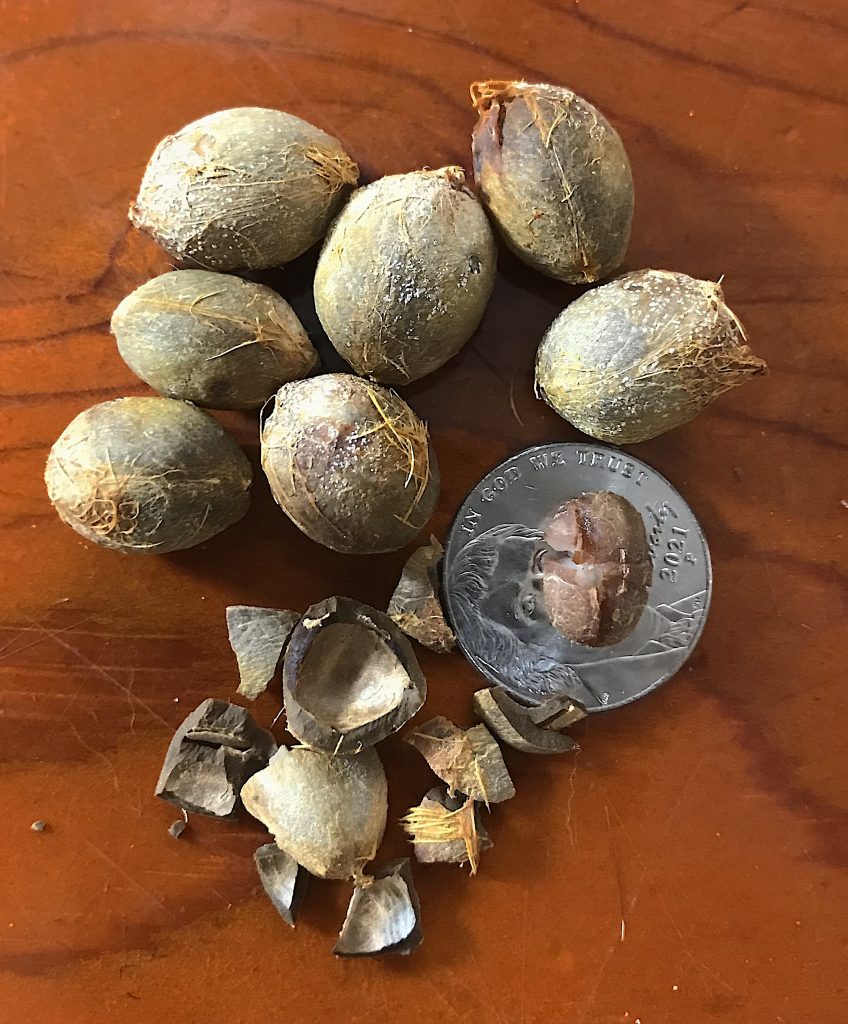
Seeds of the Pindo Palm fruit are intensely flavored. Photo by Green Deane
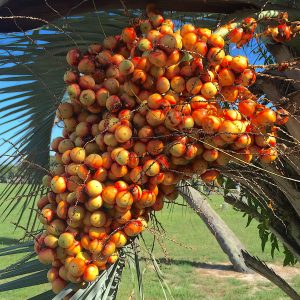
Pindo Palm can fruit almost anytime. Photo by Green Deane
It would be convenient if Pindo Palms fruited regularly. As it is they favor the spring but one can find them dropping fruit almost any month. Recently one near me in a Lowe’s parking lot was shedding a lot. I like to eat the fruit and make wine from it often. This past week I made jelly. Making that preserve is a skill and not one of my best (neither do I bake well.) I usually end up with syrup. The species is also called the Jelly Palm because in the past before we had stores providing us with food and supplies one could make jelly from the fruit without having to add any sugar or pectin. My other object this week were the seeds.
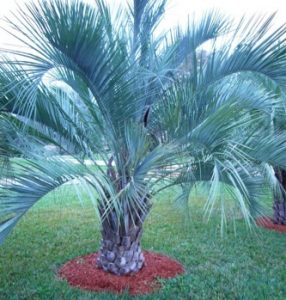
Pindo Palms are usually short and stalky. Photo by Green Deane
I cooked the fruit then let it cool. Then I squeezed the fruit to soften the fibers and release more juice. Once I drained that for the jelly I separated out the seeds and let them air dry. A little bigger than garbanzo peas they are easy to crack. The seed inside tastes intensely of coconut though the flavor is a bit more complex than that. Maybe a hint of cocoa? Regardless they are tasty and we ate some at both of my foraging classes this past weekend. You can also eat the fruit, then crack the uncooked seed and eat it. To read more about the Pindo Palm go here, to see a video go here.
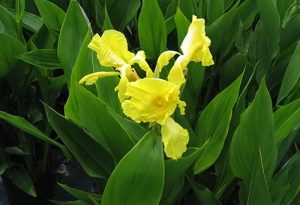
Canna are natives of North America though it took decades to discover that
When it comes to plants you can see something for a long time but not see it. That was my experience with Canna. In the late 80’s a friend of mine had Canna planted along her house. As she was from Taiwan I presumed — like most of the plants around her home — they were native to Asia. As it turned out I was just one in a very long line of people thinking this native of the Americas was actually Asian. I didn’t make the connection to local Canna because the two species have different blossoms, one skinny and red, the other fat and yellow. But then one day while fishing along the St. Johns River east of Sanford I saw a large stand of “native” Canna and investigated. There are several edible parts to the Canna including the roots. The hard seeds, however, have been used as a substitute for buckshot… they are that hard. You can read more about this peripatetic beauty here.

Classes are held rain or shine (but not during hurricanes.)
Foraging Classes: The next two weeks are supposed to hurricane free so attending classes should be easy.
Saturday September 11th, Dreher Park, 1200 Southern Blvd., West Palm Beach, 33405. 9 a.m. to noon, meet just north of the science center.
Sunday September 12th, Colby-Alderman Park: 1099 Massachusetts Street, Cassadaga. Fla. 32706. 9 a.m. to noon, meet near the bathrooms.
Saturday September 18th, Bayshore Live Oak Park, Bayshore Drive. Port Charlotte. 9 a.m. to noon, meet at the parking lot at Bayshore and Ganyard Street.
Sunday September 19th, Mead Garden: 1500 S. Denning Dr., Winter Park, FL 32789.
October 9th and 10th, Honea Path, South Carolina, classes at 9 a.m. and 1 p.m. each day. 1624 Taylor Road Honea Path, SC 29654.
For more information, to pre-pay or sign go here.
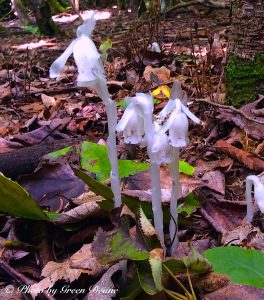
For small plants Indian Pipes/Ghost Pipes get noticed often. Photo by Green Deane
Several plants were called “Indian Pipes” where and when I was growing up. One of them is the Monotropa uniflora. Living more like a mushroom than a plant it sprouts up in various edibility conversations. It helps focus the issue on exactly what “edibility” means. Other than allergies, edibility does imply it will not kill you or harm you in any significant way. But “edibility” does not have to imply tasty. As forager emeratus Dick Deuerling used to say “there are a lot of edible plants. I only eat the good stuff.” There are also things that are just too woody or bitter to eat more than a sample of but are included in “edible.” And some plants have to be prepared correctly to be “edible.” Is the Monotropa uniflora edible? Yes. Does it taste good? Only if you’re really hungry. But that is understandable. The list of edible plants has to include everything from incredibly delicious food to only-if-I-were-starving food. Indian Pipes are closer to the famine food end of that list. You can read more about the Monotropa here.
In the olden BC days... before computers… Labor Day meant you went back to school the next day. School also let out sometime in June. Your release date was never exact because several “snow days” were built into the calendar every year. If they weren’t used up we got out in early June. If it was a bad winter then we got out mid-June. We also were not too far removed from harvest time on both ends of the school year.
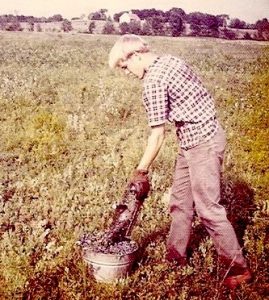
Harold Grandholm, a high school and college classmate, raking blueberries off the road I grew up on during “summer vacation.”
I walked to school daily, five miles round trip, and that was my preference. The wander took me past blueberry fields, Concord grape hedgerows, apple orchards and a great view of New Hampshire’s Mt. Washington some 60 miles away. I was scrumping every morning and afternoon for six weeks or so. This daily Too & Fro also included crossing the Royal River which was really more of a serf stream except during the spring floods. (I fished and fell into the Royal a lot. Found my first black pearl there and caught my first eel there.) All that wild fall fruit always ruined my supper but then again my mother was a horrible cook so it worked out well. In September and October you also sized up last year’s now dry wood. We had two wood stoves. And once there was snow on the ground that meant “pulping” which is cutting next year’s firewood so it can “season” for a year. Plants were also part of school letting out in spring. I noticed way back in sixth grade that when the (edible) Lilacs blossomed school was nearly out for the summer… and summer vacations were wrongly named: For most kids where I grew up it meant farm work until school started in September. For me it was three full months of working in the hay fields, a hot, dusty, hornet-punctuated job. My mother collected horses (and other farm animals) and they had to be fed so into the fields I went, indentured labor. There was also summer gardening, 70 days of it. I only escaped all that by volunteering for the Army in 1969 when Vietnam was hot… young men can make stupid decisions… but I never hayed again.

Green Deane videos are now available on a USB.
My nine-DVD set of 135 videos has been phased out and replaced by a 150-video USB. The USB videos are the same videos I have on You Tube. Some people like to have their own copy. The USB videos have to be copied to your computer to play. If you want to order the USB go to the DVD/USB order button on the top right of this page or click here. That will take you to an order form. I’d like to thank all of you who ordered the DVD set over the years which required me to burn over 5,000 DVDs individually.

Green Deane Forum
Want to identify a plant? Perhaps you’re looking for a foraging reference? You might have a UFO, an Unidentified Flowering Object, you want identified. On the Green Deane Forum we — including Green Deane and others from around the world — chat about foraging all year. And it’s not just about warm-weather plants or just North American flora. Many nations share common weeds so there’s a lot to talk. There’s also more than weeds. The reference section has information for foraging around the world. There are also articles on food preservation, and forgotten skills from making bows to fermenting food.
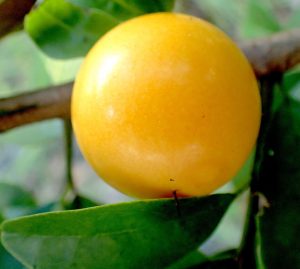
Tallow Plums are tasty wild treats. Photo by Green Deane
Found a lot of Tallow Plums this past weekend. It’s a good time of year to find them. Bright yellow fruit on short spiny bushes. We’ve mentioned them several times in previous newsletters. This weekend they ranged from Sarasota to Melbourne. While they are listed as growing in the central part of the state I have only seen them in two locations mid-state over the past 30 years: On the West Orange Bike Trail in Winter Garden and Ft. Mead park south of the powerlines. They ripen from sour to sweet and tart. Always a popular find. And on Labor Day we actually did a mushroom walk finding chanterelles, milk caps, and boletes. A bit of a treat was finding a few early-season persimmons. One aims for October locally but persimmons can be found ripe from late August to early January.
This is weekly newsletter #473. If you want to subscribe to this free newsletter you can find the sign-up form in the menu at the top of the page.
To donate to the Green Deane Newsletter click here.


always well written .I grew up in western mass,. N. Egremont , did many same things you have . Question any info. on GROUND CHERRY?
Thank you.Don